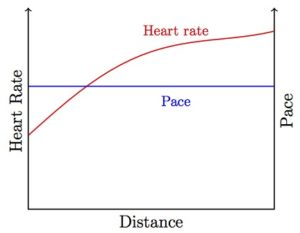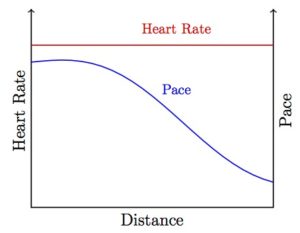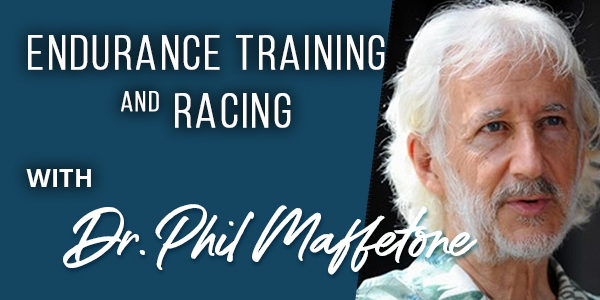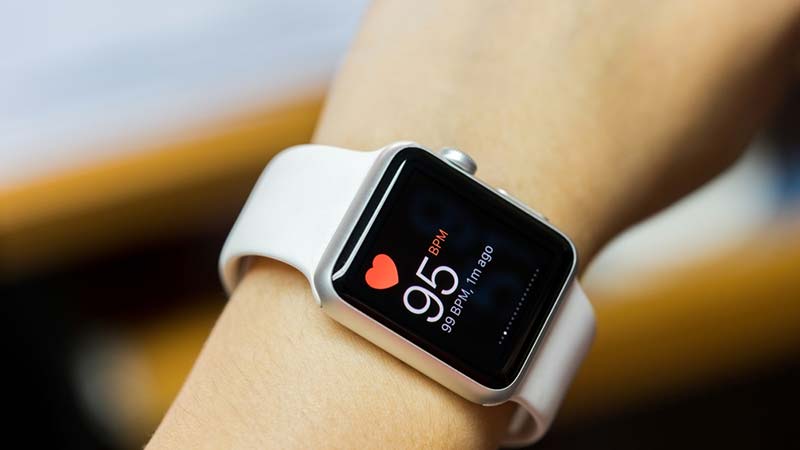
Comparing power to heart rate provides insight to two very different models of exercise intensity as it relates to endurance.
Anyone who has ever exercised with a heart-rate monitor knows what happens over the course of a training session — maintaining a steady intensity level results in an increased heart rate (HR).
HR rises over the course of a workout because as the body tires it has to work harder to maintain the same power output. This is true of any endurance activity: walking, running, cycling, rowing, and others. Upon careful evaluation of our other day-to-day activities we would also find this same phenomenon occurring — which is why many people feel fatigued at day’s end.
This phenomenon can also be measured in terms of power output. Power-focused exercise is a traditional approach, one solidified during the running boom of the 1970s. A runner, for example, would focus on a 5-mile run at an 8:30 min/mile pace. Other power-based formats include, pace (minutes-per-mile or -kilometer), speed (miles or kilometers-per-hour), wattage output and others.
This approach has obvious benefits, such as facilitating the tracking of caloric and power output. However, it also has important drawbacks. In a workout in which power output remains steady, the observed rise in HR is known as cardiac drift (see Figure 1). This is easily measured during exercise, and well described in the scientific literature.(1-3) However, it is usually treated as a casual observation that holds little value, and at worst, as evidence that heart rate is an unhelpful biometric.
FIGURE 1. Cardiac Drift at a Constant Pace
The problem underlying this view is that caloric output and pace are not the best indicators of the body’s internal physiological performance. In a workout guided by power, many people have wide ranges of HRs and metabolic responses, sometimes from below aerobic thresholds to above anaerobic thresholds and higher. But all these responses can be effectively measured through HR. The information it provides — which could be used to help improve health, reduce injuries, regulate body fat and develop athletic performance — is easily overlooked when following the traditional training format of maintaining a specific power output while letting HR drift as it may.
Except for research purposes, measuring cardiac drift may be relatively unhelpful because it only reveals that the body is working harder (but not how hard). Consider the HR elevation in Figure 1. Over the course of the workout, fat-burning is reduced while glucose use rises, and muscle fatigue elevates.
These and other metrics cannot directly be measured by most people — but they can be indirectly measured through HR. An approach that focuses on maintaining the same HR guarantees that the same percentages of fuel use (and the same level of overall physiological commitment) is maintained throughout the workout.
In effect, this allows us to track how the body tires in response to the workout. We also can measure the rate of decrease in power (watts), speed (mph) or pace (min/mi) to quantify how quickly this occurs. We can refer to this metric by the same name we give to this physiological phenomenon: fatigue. Monitoring fatigue has much more potential value than observing cardiac drift.
FIGURE 2. Fatigue Increase at a Constant Heart Rate
The body’s fatigue — a crucial factor in sports — reduces pace, speed and, along with contributing to gait irregularity, lower movement economy and reduced performance. A decrease in running pace during a marathon, for example, is positively related to blood markers of muscle damage.(4) The better we can regularly measure fatigue, the more value it can have as a metric.
Fatigue occurs in our bodies at varying rates. In addition to being relative to a workout’s time and intensity, it also relates to the individual’s overall health and fitness status. External factors such as temperature and humidity also have an impact, as do other factors such as hills and altitude.
Assessing fatigue using changes in HR and power output, as indicated in Figure 2, even without the benefits of blood tests or laboratory evaluations, can provide a useful assessment tool that may be related to a number of important factors (5-8):
- Substrate utilization (fat- and sugar-burning).
- Stress hormone response.
- The autonomic nervous system.
- Recovery requirements.
- Neuromuscular fatigue.
- Gait and movement economy.
- Other complex, interrelated adaptations by the brain and body.
All these factors are influenced by fatigue, can potentially reduce exercise benefits, and may even impair both health and fitness. Other HR evaluations have long been important assessment tools, including:
- Resting HR.
- HR recovery.
- Heart rate variability (HRV).
- The MAF Test (examples below).
Evaluating HR, instead of applying the traditional power-based approach during exercise, could play a vital role in helping individuals balance health and fitness, especially for those without access to laboratory testing. This is also useful for clinicians, coaches and scientists, and is applicable to all types of workouts, from submaximal exercise to high-intensity training and competition, as well as for rehabilitation and beginner exercisers.
Submax Fatigue
We generally associate fatigue with harder workouts, but it actually develops during all movement. The concept of submax fatigue is specifically important because submax exercise may provide the most health benefits with the lowest risk. In short, moderate fatigue may produce a more significant physiological response than more extreme fatigue. For competitive athletes, submax performance may be the best predictor of endurance performance, in part due to its relationship with fatigue.
Specifically, measuring changes in power in relation to exercise HR can help an athlete assess fatigue, especially during submax states, the type most people perform. This was demonstrated in a study by Wingo and Cureton who showed that during submax cycling for 45 minutes maintaining a steady HR, power output decreased 37 percent, VO2 decreased 24 percent and VO2max decreased 7.5 percent.(2)
The same idea is presented below during a field test by two runners. After an easy 15-minute jogging warmup, each runner performed a 10-mile submax run on a 400-meter track using a heart monitor to maintain the same HR of 146, with each one-mile split recorded.
Figure 3.: Trends of speed and pace of two runners, both at a constant submax HR of 146 BPM, as submax fatigue increases.
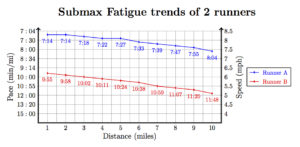 In Figure 3, submax fatigue is measured as a slowing of pace while maintaining the same submax exercise HR. While Runner A has increased fitness due to the ability to run faster at the same HR, both fatigue at about the same relative rates as indicated by percent reduction in pace. This submax field test, also called the maximum aerobic function (MAF) test developed in the early 1980s by the author, is relatively accurate and simple enough for virtually all exercisers to perform regularly.(6)
In Figure 3, submax fatigue is measured as a slowing of pace while maintaining the same submax exercise HR. While Runner A has increased fitness due to the ability to run faster at the same HR, both fatigue at about the same relative rates as indicated by percent reduction in pace. This submax field test, also called the maximum aerobic function (MAF) test developed in the early 1980s by the author, is relatively accurate and simple enough for virtually all exercisers to perform regularly.(6)
An important goal of exercise is to reduce fatigue while maintaining a given work-rate, or to increase speed at the same HR, for example. This would be demonstrated a month later in the runners in Figure 3, when their submax speeds were faster at the same HR. In addition to reduced fatigue, these changes are also associated with increased fat-burning, aerobic development, improved competitive performance, and others.(5-7)
More on Fatigue
Fatigue is a double-edged sword: too little and the body is not stressed enough to obtain positive training benefits that improve health and fitness. Excess fatigue, which commonly occurs when following a power-based workout where HR rises (cardiac drift), can induce unhealthy stress. This level of fatigue requires longer recovery times, with the real potential for causing muscle weakness, gait irregularity, reduced economy, injury and overtraining, as part of an overall impairment of health. Dawson and colleagues had cyclists train for four hours starting at a submax intensity, with rising heart rates/cardiac drift.(3) Afterwards, through electrocardiographic assessment, the subjects showed evidence of cardiac dysfunction.
There is no doubt that parameters of heart function — cardiac output, stroke volume, and redistribution of blood flow to the skin — change measurably as part of the process of adapting to fatigue. But so does the metabolism: it manipulates the balance of fuels (fat and sugar). Muscles respond to increasing fatigue by enlisting more fiber contraction. In addition, reductions of VO2max also occur throughout the workout.(2) Without the ability to regularly measure heart rate during exercise, one may only be able to improve while risking injury, overtraining and reduced health (often, without knowledge of the risk involved).
Special thanks to Ivan Rivera for editing and graphics, and Hal Walter for editing.
References
- Wingo JE, Cureton KJ. Body cooling attenuates the decrease in maximal oxygen uptake associated with cardiovascular drift during heat stress. Eur J Appl Physiol. 2006 Sep;98(1):97-104.
- Wingo JE, Cureton KJ. Maximal oxygen uptake after attenuation of cardiovascular drift during heat stress. Aviat Space Environ Med. 2006 Jul;77(7):687-94.
- Dawson EA, Shave R, George K, Whyte G, Ball D, Gaze D, et al. Cardiac drift during prolonged exercise with echocardiographic evidence of reduced diastolic function of the heart. Eur J Appl Physiol. 2005 Jun;1(94):305-9.
- Del Coso J, Fernández D, Abián-Vicen J, Salinero JJ, González-Millán C, Areces F, et al. Running pace decrease during a marathon is positively related to blood markers of muscle damage. PloS one. 2013 Feb 27;8(2):e57602.
- Maffetone P. White Paper. An Introduction to MAF: Maximum Aerobic function. Independent. 2016. https://philmaffetone.com/white-paper-introduction-maf-maximum-aerobic-function/
- Maffetone P. White Paper. MAF Exercise Heart Rate: How it can improve health and sports performance. Independent. 2016. https://philmaffetone.com/white-paper-maf-exercise-heart-rate-can-help-improve-health-sports-performance/
- Maffetone P. Marathon Pace Prediction. Indpendent. 2016. https://philmaffetone.com/original-research-marathon-pace-prediction/
- Maffetone PB, Laursen PB. Athletes: Fit but Unhealthy? Sports Medicine – Open. 2016;2(1):1-4. https://sportsmedicine-open.springeropen.com/articles/10.1186/s40798-016-0048-x

